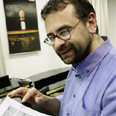
Francesco Lotoro
צילום: איי פי
Music of WWII victims finds new life
New library, set to open in September, to offer scholars repertoire of 4,000 papers and 13,000 microfiches, including music sheets, letters, drawings and photos
A waltz. A tango. A piece of jazz. But they weren't composed in Vienna, Buenos Aires or New Orleans. Scribbled on diaries, loose pages or even toilet paper, these are the notes left behind by people who lived and died in the prisons and concentration camps of World War II.
Italian researchers hope thousands of nearly forgotten works will find new life as they assemble a library of music composed or played in those dark places between 1933 and 1945.
"We are trying to right a great wrong: These musicians were hoping for a musical life for themselves, and they would have had it if their destiny had been different," said Italian musician Francesco Lotoro.
He has been collecting originals, copies and recordings of everything from operas composed in the depth of the Nazi death machine to jazz pieces written in Japanese POW camps in Asian jungles.
The library, set to open in September at Rome's Third University, will offer scholars a repertoire of 4,000 papers and 13,000 microfiches including music sheets, letters, drawings and photos.
Music is life
For more than 15 years, working largely alone, Lotoro has been crisscrossing the globe, usually at his own expense, hunting down musical works from museums, archives and antique shops, as well as from survivors or their families.
Lotoro, a pianist, is also rearranging and recording many of the pieces to produce a collection of 32 CDs, five of which have already been published. Musicians and singers who live in or around his southern Italian town of Barletta, and who share his passion, often spend their Sundays working with him in the recording studio.
Experts who are aware of Lotoro's work say it's the first time such a vast effort has been made to assemble and revive in one place a musical treasure trove scattered around the world.
"I don't know of any institution gathering only musical documentation," said Bret Werb, the musicologist at the U.S. Holocaust Memorial Museum in Washington. "It's an important project that will become an important resource for musicians globally."
In an interview, Lotoro said he is constantly discovering new works, "and this is not a good sign; it's a sign that history hasn't done its job."
Lotoro, 42, says his ancestors were Jews forced to convert to Christianity centuries ago. Attracted to Judaism in his teens, he converted in 2002.
He first looked into music written during the Holocaust on a 1991 trip to Prague — and quickly got a sense of the task ahead.
"I left for two weeks with a small bag hoping to bring back a dozen works, but in the end I had to buy a bigger suitcase to carry home hundreds of manuscripts and photocopies," he recalled.
Finding a long-sought piece is only the beginning, since it may well be fragmentary and written clandestinely or in haste, Lotoro said.
'Prisoners' March'
Among the key works he has labored on for the last decade are those of Rudolf Karel, a Czech composer arrested by the Nazis for taking part in the resistance in Prague.
Locked up in a military prison and plagued by dysentery, Karel used mostly toilet paper to compose a vast repertoire, including a five-act opera and a nonet, a composition for nine instruments.
The last of his music sheets found by Lotoro is an upbeat "Prisoners' March" dated four days before his death in March 1945.
Many of Lotoro's finds are works written in Theresienstadt, a Czech town used by the Nazis from 1941 as a ghetto and transit camp to which Jewish leaders and prominent artists were deported from all over Europe.
Theresienstadt — Terezin in Czech — was used by the Germans as a propaganda tool to hide their extermination plans from international organizations, and inmates were able to stage operas, concerts and cabaret shows with several orchestras, including one called the "Ghetto Swingers."
All the same, of the 140,000 Jews sent there, 33,000 died and nearly 90,000 were deported to death camps.
The Rome library will include works by Gypsies imprisoned by the Nazis; chorus songs by Dutch women interned by the Japanese in Indonesia, and the music of Edmund Lilly, a U.S. colonel from North Carolina who wrote songs and poems as he went through various Japanese camps from surrender in the Philippines in 1942 to liberation in Manchuria more than three years later.
Also in the library are the works of Berto Boccosi, an Italian captain who started writing an opera while held by the Allies in an Algerian camp. And Lotoro says he is looking into music written by German officers imprisoned in Soviet camps.
"Music is a universal language, so the music written by the German officer and by the Jewish prisoner have the same historical value," Lotoro said.
He said he hopes the library will give scholars greater understanding of "the explosion of creativity" that gave birth to a tango in Buchenwald or a waltz in the Italian camp of Alberobello.
"You can always feel the tragedy in the background, but in his creative effort a musician is capable of escaping reality," he said.
But the music could also contain the seed of defiance, as in the "March of Terezin," which was played after cabaret shows in Theresienstadt and begins with the opening notes of "Hatikva" — the future Israeli national anthem.
If nothing else, music was a way for prisoners to stay sane.
"Composing for an author is a question of mental survival," said David Meghnagi, a psychology professor at the Third University who is spearheading the creation of the library. "In this way he keeps his humanity intact and allows his mind to imagine a different future."










